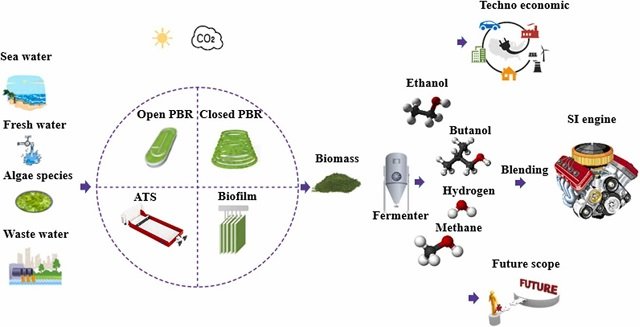
Microalgae play various important roles in aquaculture, whether as live food for larval stages of aquaculture species, as feed ingredients, or in the treatment of effluents from aquaculture operations.
However, when cultivating microalgae as live food, the main challenges are the high cultivation costs, low harvesting rates, and low biomass production, which hinder the industrialization of these microalgae.
Currently, microalgae are mainly cultivated using the photoautotrophic mode due to its low energy consumption. However, this method often results in limited biomass accumulation.
On the other hand, although heterotrophic cultivation can produce higher biomass than photoautotrophic cultivation, it still faces several challenges, including the high cost of organic carbon, long growth cycles, and harmful bacteria.
Meanwhile, mixotrophic cultivation is still being extensively researched but has not yet been implemented on a large scale.
Researchers from the Ningbo Institute of Oceanography, Ningbo University, the NRC “Kurchatov Institute,” Novosibirsk State Agrarian University, and Lijiang Cheng Hai Bao Er Biological Development Co., Ltd. published an article on the main strengths and limitations of photoautotrophic, heterotrophic, and mixotrophic microalgae cultures for their application in different aquaculture processes.
Photoautotrophic Cultivation of Microalgae
In photoautotrophic cultures, CO2 and light (light period and intensity) are the main factors that affect the growth of photoautotrophic microalgae, and light energy is converted into cellular substances.
In aquaculture, photoautotrophic microalgae have obvious economic advantages. There is no addition of carbonate, which would not lead to excessive alkalinity in the water.
Stay Always Informed
Join our communities to instantly receive the most important news, reports, and analysis from the aquaculture industry.
However, the photoautotrophic mode has obvious disadvantages in aquaculture. It heavily relies on external conditions, and a shortage of solar energy can reduce the density of microalgae and promote bacterial multiplication.
On the other hand, photoautotrophic cultivation yields lower algal biomass compared to other cultivation modes.
Heterotrophic Cultivation of Microalgae
In heterotrophic cultures, microalgae absorb external organic carbon to synthesize biomass and reproduce under dark conditions.
Heterotrophs do not rely on external sources of inorganic carbon or light energy. As a result, photosynthesis is reduced, but cell density and biomass increase relatively.
However, not all microalgae are capable of heterotrophic growth. This mode of microalgae cultivation has significant advantages in aquaculture.
Advantages include the dependence on organic carbon sources to provide energy, thus preventing bacterial reproduction by using up the nutrients.
Furthermore, the biomass of microalgae produced through this cultivation mode is always greater than under photoautotrophic conditions, which may be due to exogenous addition of organic carbon.
However, it also presents some disadvantages. For example, due to the organic carbon, bacteria and fungi can utilize it for reproduction and antagonize with the microalgae.
Mixotrophic Cultivation of Microalgae
In mixotrophic cultivation, microalgae can utilize light energy and external inorganic carbon to provide the required CO2 for photosynthesis, as well as absorb external organic carbon to provide energy for growth.
In this type of cultivation, microalgae can obtain the required energy for the dark reaction phase and the necessary oxygen for the tricarboxylic acid cycle. They can also utilize inorganic carbon to store products of the dark reaction for catabolism.
Advantages of mixotrophic cultivation include:
- Most mixotrophic cultures have higher density and biomass.
- Active substances that are not available in other cultivation modes can be obtained.
However, the conditions for mixotrophic cultivation are strict, such as suitable light source, inorganic carbon, organic carbon, and temperature for microalgae growth.
Finally, the cost of mixotrophic cultivation is higher than that of photoautotrophic and heterotrophic cultivation. Equipment modification and technical limitations can lead to increased production costs.
Conclusion
The different modes of microalgae cultivation in aquaculture face several challenges that need to be addressed.
“The photoautotrophic mode is low-cost but has low biomass. In heterotrophic cultivation, some microalgae can produce higher biomass, but the addition of organic carbon is easily utilized by bacteria. In mixotrophic cultivation, most microalgae produce higher biomass and bioactive substances, and the assimilation of organic and inorganic carbon can be reduced,” concludes the study.
Furthermore, biomass and nutrient accumulation in microalgae vary depending on different cultivation methods. In fact, mixotrophic cultivation conditions can promote the accumulation of polyunsaturated fatty acids and other nutrients, which can serve as high-quality food and ensure the successful development of larvae from different aquaculture species.
“In summary, selecting the appropriate cultivation mode for microalgae in aquaculture is important. This can be considered in terms of their own reproduction and the body of water or animals being raised,” the researchers concluded.
The study was funded by the National Key Research and Development Program, the National Natural Science Foundation of China, the Natural Science Foundation of Zhejiang Province, and the Yunnan Key Laboratory of Microalgae.
Reference (open access)
Cheng P, Shan S, Zhu Z, Liu K, Namsaraev Z, Dubovskiy I and Xu Q (2023), The role of microalgae culture modes in aquaculture: a brief opinion. Front. Bioeng. Biotechnol. 11:1196948. doi: 10.3389/fbioe.2023.1196948
Editor at the digital magazine AquaHoy. He holds a degree in Aquaculture Biology from the National University of Santa (UNS) and a Master’s degree in Science and Innovation Management from the Polytechnic University of Valencia, with postgraduate diplomas in Business Innovation and Innovation Management. He possesses extensive experience in the aquaculture and fisheries sector, having led the Fisheries Innovation Unit of the National Program for Innovation in Fisheries and Aquaculture (PNIPA). He has served as a senior consultant in technology watch, an innovation project formulator and advisor, and a lecturer at UNS. He is a member of the Peruvian College of Biologists and was recognized by the World Aquaculture Society (WAS) in 2016 for his contribution to aquaculture.




